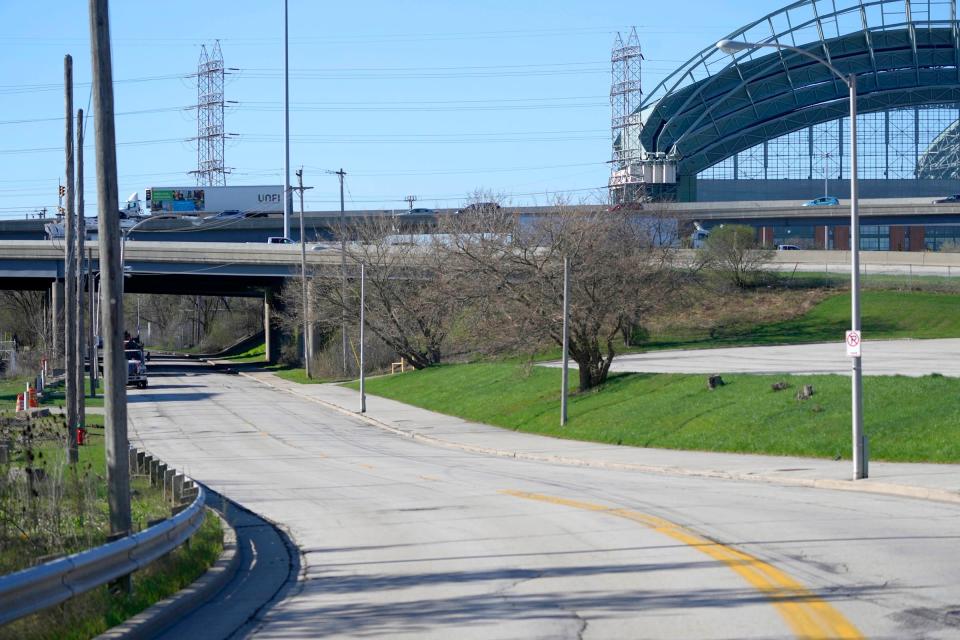I-94 project focuses on adding lanes. But it includes nearby bike, pedestrian improvements
Interstate 94's widening on Milwaukee's west side will take around six years and cost an estimated $1.74 billion − work designed to reduce congestion and improve safety, according to the Wisconsin Department of Transportation.
One overlooked project aspect: it features several nearby bike and pedestrian improvements to occur from 2026 to 2032. That includes connecting the Hank Aaron State Trail with the Oak Leaf Trail.

Here's what to know.
I-94 will expand to eight lanes
The project centers on widening I-94 from six lanes to eight lanes between 16th and 70th streets.
WisDOT says that's needed to reduce congestion and improve safety. Business groups and construction labor unions are among those supporting the project.
Opponents say those goals can be accomplished with a six-lane rebuild. They say adding lanes will bring more auto emissions that add to climate change.
Opponents want alternatives to driving
Freeway expansion opponents say Milwaukee-area residents need more alternatives to driving, including better mass transit service as well as more protected bike lanes.
WisDot says the Southeastern Wisconsin Regional Planning Commission's Vision 2050 regional transportation plan concluded a six-lane I-94 would still see extreme congestion even if existing transit services were doubled − as recommended by the commission's plan.
The department also says widening I-94 "will not preclude transit improvements," according to documents filed with the Federal Highway Administration.
That includes Milwaukee County Transit System's Connect 1 bus rapid transit, which uses nearby Wisconsin Avenue and Blue Mound Road to connect downtown Milwaukee and Wauwatosa's Milwaukee Regional Medical Complex, and the proposed Connect 2 bus rapid transit running on 27th Street between Oak Creek/Franklin and Glendale − with that route crossing I-94.
Hank Aaron State Trail and Oak Leaf Trail connection planned
WisDOT's planned bike lane improvements include a new connection between the Hank Aaron State Trail, which runs south of I-94, and Milwaukee County's Oak Leaf Trail, part of which runs through Doyne Park − well north of I-94, at Wells Street and the Stadium Freeway.
The connection would run along 44th Street, including a portion beneath I-94 east of the Stadium Freeway.
North of Blue Mound Road, the existing 6-foot sidewalk on the west side of 44th Street would remain, and WisDOT would add shared-lane pavement markings for bikes along 44th and Wells streets.
South of Blue Mound Road, the existing path/sidewalk on the west side of 44th Street would remain, and WisDOT would build a 10-foot shared-use path on the east side of 44th Street.
Also, a new access point would be added to the Hank Aaron State Trail. The paved connection would be about 50 feet long and provide access to the trail directly from Dickinson Street, near 64th Street − about three blocks south of I-94.
Currently, there is no trail access near Dickinson Street between 68th and 60th streets.
Meanwhile, WisDOT and the city officials are working on plans to add off-road bike paths along portions of 70th Street, 68th Street and Hawley Road near I-94, and on O'Connor Street west of 68th Street.

Menomonee Valley to see trail improvements
A connection between 32nd and Greves streets, just south of I-94, might be built to provide better pedestrian and bicycle access to the Menomonee Valley − depending on nearby electrical facilities relocation plans, according to WisDOT.
WisDOT is to construct a 10-foot shared-use path connecting 32nd Street with Greves Street.
On Greves Street, the existing 6-foot sidewalk on the road's north side west of 25th Street would remain. WisDOT might add a new sidewalk from 25th Street east to St. Paul Avenue on Greves Street's north side. WisDOT plans to add shared lane pavement markings for bikes.
Also, WisDOT will build a 10-foot shared-use path on the west side of 25th Street north of St. Paul Avenue, and a 10-foot shared-use path on the east side of 25th Street south of St. Paul Avenue. That connects the Menomonee Valley to the neighborhood north of I-94.
The department also will add 6-foot sidewalks along 26th Street and traffic signals at the intersection of 25th and 26th streets with St. Paul Avenue. That will allow pedestrians and bicyclists to safely cross those streets to reach the path.
Biking advocates welcome the changes
Biking advocates support the changes − particularly the new links between trails that improve safety.
"We're always looking for connections," said Mitch Henke, chair of the city's Pedestrian and Bicycle Advisory Committee. "Even a one-block gap can have an impact."
Off-road bike trails and protected bike lanes − the latter are often screened from auto traffic by concrete barriers, parking lanes and other means − lead to a much higher percentage of people willing to bike, Henke said.
Henke, however, is skeptical of claims that widening I-94 will improve safety for bikers by diverting more cars from surface streets to the freeway.
"Maybe it takes some of the pressure off surface streets," Henke said. "But I think the degree is insignificant."
Wisconsin Bike Fed Assistant Director Jake Newborn said his group strongly encourages WisDOT and local officials ensure the bike and pedestrian projects are done to the highest standards.
Those projects "are a mere drop in the bucket" of the I-94 expansion's overall cost, Newborn said.
The group also wants additional improvements, including repaving and widening the Hank Aaron State Trail from Sixth Street to Selig Drive; redesigning the roundabout at Canal and 25th streets to slow down traffic, and repaving and widening a trail segment along the Menomonee River's south bank between 13th and 25th streets.
Tom Daykin can be emailed at tdaykin@jrn.com and followed on Instagram, X and Facebook.
Subscribe to get the BusinessWatch email newsletter.
This article originally appeared on Milwaukee Journal Sentinel: Milwaukee freeway project adds lanes--and bike/pedestrian improvements


